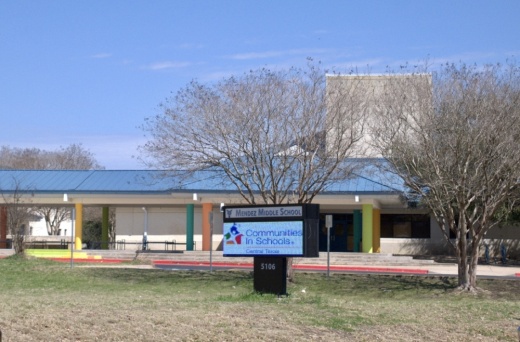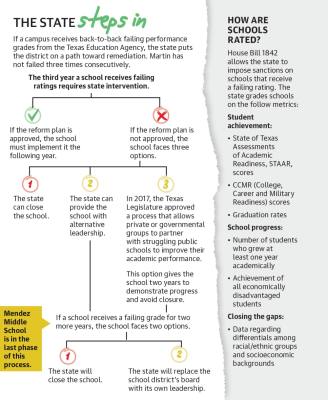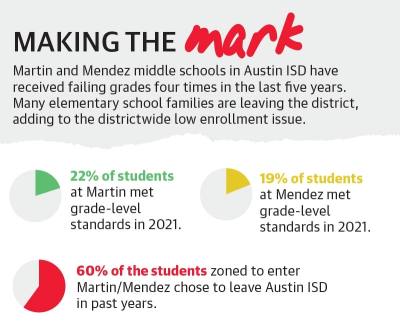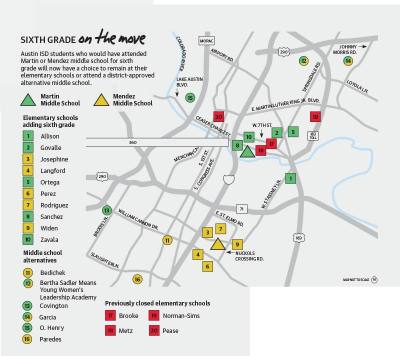Austin ISD will stop offering sixth grade at Martin and Mendez middle schools in East Austin next fall, a move district leaders say will improve both schools’ poor academic ratings and provide a much-needed enrollment boost to other schools in the district.
“We lose approximately 60% of students that are going from fifth grade to sixth grade within the Mendez and Martin vertical team,” AISD Chief of Schools Anthony Mays said in a Facebook Live discussing the transition.
Students who would have entered sixth grade at Martin and Mendez middle schools will now have the option of remaining at their elementary school an additional year. Having sixth grade at elementary schools is not new to AISD, which already has four schools with sixth grade.
Prospective Mendez and Martin students can also choose to move to a alternative middle school.
With the focus on seventh and eighth grade students, district leaders are hopeful that academic performance at Martin and Mendez will improve.While some are worried the move is a precursor to the campuses closing, Mays said the move is directed at improving current conditions.
“The goal is to make all of our campuses strong options,” Mays said.
What is happening?
In the last week of January, Eric Ramos, a sixth grade special education teacher at Martin Middle School, was summoned to a meeting.
“When we got to the meeting, they told us, ‘These are your options for employment next year,’’’ Ramos said. “When we asked what they were talking about, that’s when they said, ‘’Oh, by the way, Martin is not going to have sixth grade next year.’”
According to Ramos, teachers were assured they would still have a job with AISD, but not all of them would be able to stay at Martin next year.
Families of Martin and Mendez students were also informed at the end of January about the decision to relocate sixth grade. A letter sent home with students explained that seventh and eighth grade would continue to be offered at the schools and detailed options for rising sixth graders. The district said sixth grade would be added to 10 low-enrollment elementary schools that feed into Martin and Mendez.
“As we bring those students back onto the campuses, the enrollment will go up,” Mays said.
The district also outlined alternate middle school options to which it will provide transportation.
“The idea of removing an entire grade level definitely made me concerned that this would just lead to the closure of Martin,” Martin parent Emily Heasley-Sawyer said. “I can’t say whether this plan will work or not. If they do it, the best thing we can all do is work to make it successful.”
Why is this happening?
Despite the city’s rapid population growth, AISD has seen mostly declining enrollment for the past decade—a trend worsened by the COVID-19 pandemic. From 2019-21, the district lost approximately 5,000 students. Many students opt for charter schools instead, according to district leaders.
In her 2021 state of the district speech, AISD Superintendent Stephanie Elizalde identified gentrification as a major factor in the district’s enrollment decline.
“[Economically disadvantaged families are] being pushed out of the city. They can’t afford to live in the areas that they formerly lived in, either because of rent, because of housing prices or because of taxes in our area,” Elizalde said.
East Austin, where Martin and Mendez are located, was home to three out of four elementary schools AISD closed in 2019 due to low enrollment. Like Martin and Mendez, each shuttered school had over 90% economically disadvantaged students.
In addition to under-enrollment, Martin and Mendez have failed to meet state academic standards multiple times since 2012.
Mendez received enough consecutive failing ratings from the Texas Education Agency by 2018 that the district opted to convert Mendez into an in-district charter school by partnering with nonprofit Texas Science, Technology, Engineering and Mathematics Coalition to run the campus.
AISD ended the T-STEM partnership in 2021 due to persistent low academic performance. Mendez will face closure or replacement of the school board if it receives another failing rating in the 2022-23 school year.
Austin ISD trustees voted March 24 to approve a new 1882 Partnership that will allow charter-network Third Future Schools to run Mendez Middle School. An 1882 Partnership refers to Senate Bill 1882, which provides incentives for school districts to partner with charter and higher education schools, nonprofits or government entities to improve academic performance at schools that receive more than three consecutive failing ratings from the Texas Education Agency.
“I had no clue about what we could do except terminate the contract and find someone else,” said trustee Ofelia Zapata, who oversees AISD’s District 2, which includes Martin and Mendez.
She said she liked the idea of removing sixth grade as another strategy to improve the campus.
The board can choose another partner or run Mendez itself in the upcoming school year.
“If we have to have a closure of Mendez to maintain an elected board, we would have to do that,” Elizalde said during a December board meeting.
What does this mean for the future?
On March 8, AISD released preliminary data on the effect that the sixth grade transition plan will have on enrollment next school year.
Per the report, nearly 70% of fifth grade families at Martin and Mendez feeder elementaries will stay enrolled at their current campus. About 20% will attend another middle school. The other 10% are undecided, moving to a magnet school or leaving the district.Zapata said parents reacted positively to the plan and that some told her they felt safer keeping students in sixth grade at their elementary schools.“The bottom line: Our sixth grade transition plan is working,” the report reads.
AISD still faces declining enrollment districtwide, which means it will receive less money from the state. The district lost about $15 million in funding last year as a result of losing students during the pandemic. Amid this ongoing struggle, Mays suggested the sixth grade transition plan at Martin and Mendez may serve as a blueprint for further reducing lower enrollment across the district.
“We want to start here—it doesn’t mean that we won’t look at this as a solution for other elementary or middle schools,” Mays said.








